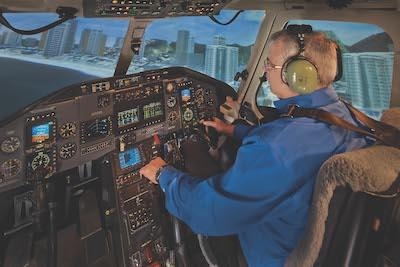Tue, Mar 05, 2019
To Add Advanced Energy Management - Rotorcraft Course
FlightSafety International will add a new Advanced Energy Management – Rotorcraft course to its Master Aviator program for helicopter pilots in the coming months.

"We are pleased to enhance the FlightSafety Master Aviator program for helicopter pilots with this new Advanced Energy Management course," said Steve Gross, Senior vice president, Commercial. "Master Aviator sets a new standard for pilot achievement and recognition, enabling pilots to develop a deeper knowledge of the helicopter they fly, as well as a safe and correct response to a broad range of demanding, unexpected situations."
FlightSafety Master Aviator for helicopter pilots is earned by completing all advanced aircraft- specific core courses and a choice of four electives. At least one FlightSafety initial or recurrent training event must also be completed every 8 months.
The one-day core courses now include Advanced Energy Management - Rotorcraft, Advanced Helicopter Crew Resource Management, and Advanced Helicopter Surviving Inadvertent Instrument Meteorological Conditions.
The Advanced Energy Management course increases a pilot’s understanding of helicopter aerodynamics and introduces techniques to improve control of the helicopter and rotor energy during normal and abnormal operations. Pilots will focus on Crew Resource Management, Energy Situational Awareness and managing the kinetic and potential energy available to them while flying.
The Advanced Crew Resource Management course enables the pilots to master the key aspects of CRM that uniquely apply to helicopter operation. This includes situational awareness, conflict resolution and communication skills. They will also experience how effective crew performance and decision-making can overcome situations caused by error chains, human factors and fatigued or stressed operators.
The inadvertent IMC course will help pilots to be fully prepared when weather conditions unexpectedly and rapidly change in order to have sound and well-practiced strategy to maintain the safety of their aircraft. This course provides the tools needed to react appropriately as decisions made in the first pivotal moments often decide the outcome. Pilots will also review and fully understand the major causes for inadvertent IMC accidents and master best practices for the safest responses.
(Image provided with FlightSafety news release)
More News
From 2014 (YouTube Version): One Of The Airshow World's Pre-Eminent Formation Teams Chats About The State Of The Industry At EAA AirVenture 2014, ANN News Editor Tom Patton gets th>[...]
Tactical Air Navigation (TACAN) An ultra-high frequency electronic rho-theta air navigation aid which provides suitably equipped aircraft a continuous indication of bearing and dis>[...]
Aero Linx: Doobert Hi, we're Chris & Rachael Roy, founders and owners of Doobert. Chris is a technology guy in his “day” job and used his experience to create Doobe>[...]
The Airplane Was Spinning In A Nose-Down Attitude Before It Impacted Terrain On June 20, 2025, at 0900 eastern daylight time, a Pitts Aerobatics S-2B, N79AV, was destroyed when it >[...]
Also: United Elite Sues, Newark ATC Transitions, Discovery Moves?, Textron @ KOSH The Commemorative Air Force Airbase Arizona is taking its “Flying Legends of Victory Tour&rd>[...]
 Classic Aero-TV: Up Close And Personal - The Aeroshell Aerobatic Team at Oshkosh
Classic Aero-TV: Up Close And Personal - The Aeroshell Aerobatic Team at Oshkosh ANN's Daily Aero-Term (07.13.25): Tactical Air Navigation (TACAN)
ANN's Daily Aero-Term (07.13.25): Tactical Air Navigation (TACAN) ANN's Daily Aero-Linx (07.13.25)
ANN's Daily Aero-Linx (07.13.25) NTSB Prelim: Pitts S2
NTSB Prelim: Pitts S2 Airborne 07.09.25: B-17 Sentimental Journey, Airport Scandal, NORAD Intercepts
Airborne 07.09.25: B-17 Sentimental Journey, Airport Scandal, NORAD Intercepts



